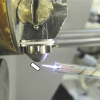Kálmán Vad,a Attila Csika and Gábor A. Langerb
aInstitute of Nuclear Research, Hungarian Academy of Sciences, H-4001 Debrecen, PO Box 51, Hungary. E-mail: vad@atomki.hu; web: http://www.atomki.hu/SNMS
bDepartment of Solid State Physics, University of Debrecen, H-4010 Debrecen, PO Box 2, Hungary
Introduction
The decrease of dimensions and increasing complexity of thin-film and multilayer structures require the application of methods that provide information down to the nanometre scale. The quantification of nanostructures and surface layers with high sensitivity is often of crucial importance in monitoring product quality. Sensitive elemental analysis, together with a quantitative chemical analysis, is a prerequisite for the preparation of thin-layer structures of good quality. Several methods based on ion sputtering exist for this purpose, e.g. secondary ion mass spectrometry (SIMS), X-ray photoelectron spectroscopy (XPS), Auger electron spectroscopy (AES) and secondary neutral mass spectrometry (SNMS). While in XPS and AES the surface is analysed by various forms of electron spectroscopy after sputtering, in SIMS and SNMS the sputtered particles themselves are detected by a mass spectrometer. This results in a difference in their practical applications. Electron spectroscopy is capable of giving information about the material structure and the chemical state of elements. The SIMS and SNMS techniques yield information about the elemental composition and the depth profile of elements.
The purpose of this article is to give a comparative description of two methods applying ion-beam sputtering in materials research: secondary ion and neutral mass spectrometries (SIMS and SNMS). We shall illustrate the application of the latter by reports on a compositional analysis of perovskite oxides and on an investigation of nanoscaled multilayer structures.





